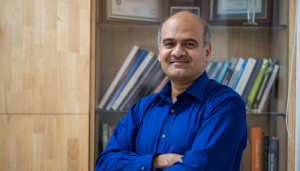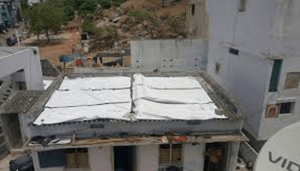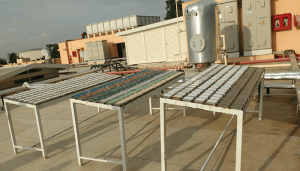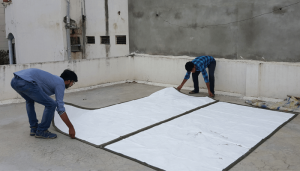If the State Govt has its way, this could well be the next urban alphabet song. With ambitious targets seeking to make the entire state of Telangana a ‘cool’ one, we speak with Prof. Vishal Garg about the implications of the State’s proposed Cool Roof policy, related research from IIIT-H’s Building Science Research Centre and the upcoming world conference on countermeasures to urban heat islands.
Hyderabad has been experiencing one of its harshest summers in recent times. In fact media reports were agog with news of the city being the hottest on earth on a particular Sunday this May (“Hyderabad is hotter than the Thar Desert”!). The searing heat wave also led to the logical extension of school holidays. Around the same time, at a seminar on ‘Cool energy and power roofs’ held at The Institution of Engineers (India), the Principal Secretary, Municipal Administration and Urban Development (MA&UD), Arvind Kumar announced a massive public awareness campaign on the importance of establishing cool roofs. The outreach and awareness measures are a precursor to implementing the Telangana State Cool Roof policy as part of the state’s heat action plan. The policy, brought out in conjunction with the Administrative Staff College of India (ASCI), Natural Resources Defence Council (NRDC), IIIT-H, and Greater Hyderabad Municipal Corporation (GHMC) aims to make Telangana State a ‘Cool’ one via a statewide cool roof program.
More Comfort, Less Energy Bills
A cool roof is a simple and cost-effective solution where, by reflecting sunlight and absorbing less heat, indoor temperatures can be lowered by 2 to 5 ℃as compared to a traditional roof. A huge plus is the increased thermal comfort of the occupants, less demand for cooling and consequent lowered energy bills. As part of its objectives, the policy aims to make cool roofing mandatory for all government (schools, hospitals and other healthcare facilities) and commercial buildings, voluntary for residential and smaller buildings, and assist all low-income housing with cool roofs. According to Prof. Vishal Garg, the IIIT-H technical brain behind the policy, “One should not force homeowners or small commercial building owners to implement cool roofs. We have to show that this whole concept is worthwhile and they will get the return on their investment. So it’s more of educating them. And for the vulnerable communities, we have to help them.” The policy has recommended various cool roof techniques and corresponding funding mechanisms for each type of building. For instance, in low-income areas, in the case of existing buildings, options such as cool coatings, recycled advertisement flex banners, or even sheets like membranes that can be wrapped up and put away post-summer, have been listed.

Rapid Scaling
What caught public and media attention at the seminar was the announcement of annual targets under the State’s cool roof policy. While the goal at the end of the first year is to have 0.1 sq km of Hyderabad and Telangana covered under cool roofs, the aim is to have 100 sq km of Hyderabad and 300 sq km of Telangana under cool roofs at the end of 2030. “With the Government extending school holidays, thanks to the heatwave, there is a pressure now. The policy implementation should definitely make a difference. The Governmentis positive and has been very supportive of this endeavour,” says Prof. Garg. But what do these targets actually mean? It would mean that at the end of 10 years, almost the entire city of Hyderabad would be covered with cool roofs. Ambitious much? “Not at all!”, exclaims Prof. Garg. He says that an initiative like this is actually not the first of its kind mentioning some metropolitan cities across the world such as New York, and Los Angeles that have undertaken to implement similar cool roof programs.
Million Cool Roofs Challenge
In a bid to offer a perspective on manatargets, Prof. Garg also goes on to talk about the Million Cool Roofs Challenge. It’s a $2 million global competition project of the Kigali Cooling Efficiency Program (K-CEP) to rapidly scale up the deployment of highly solar-reflective “cool” roofs in developing countries suffering heat stress and lacking widespread access to cooling services. One of the judgement criteria of the challenge is to meet a target of 1 sq km of cool roofs in a single year. “What Hyderabad is doing is impressive because 100 sq km is going to be a huge program. But the targets are doable in the sense that there are challenges that are about 10 times that of our first year target. It’s only by 2022-23 that we’re talking of covering 1 sq km and there (Million Cool Roofs) they are talking of covering 1 sq km in the first year itself.” Incidentally, India not being a signatory could not participate in this challenge.
While the program is plausible driven with the right intent, Prof. Garg expresses reservations about the manner in which large-scale implementation of any program takes place. “My real worry is about the poor quality of material, and bad implementation getting in the way when you’re trying to scale. Bad publicity and dismissing the concept of cool roofs should not take place”, he says.

A Suitable Choice
There are broadly four categories of cool roof techniques ranging from the simplest which involves coating of a roof with a white paint with high solar reflectivity, to laying of china mosaic tiles on roofs, to using pre-fabricated membranes or sheeting to cover roofs and finally growing a green patch on roofs (think terrace gardening).
Research is still underway at the Center for IT in Building Sciences (IIIT-H) to determine which material works best and on what kind of roof, especially when one takes several years into account. Sraavani Gundepudi, a Research Fellow at the Center is simultaneously testing out 20 samples of different materials by exposing them on roof-top racks to the vagaries of the atmosphere and weather over a period of 5 years across 4 cities – Bangalore, Hyderabad, Mumbai and Ahmedabad. The tests are conducted with the support of CEPT Ahmedabad. “After every quarter, we test to see how much reflectance they retain,” she says. This is known as aged performance. “We want materials with higher aged performance and not just high initial performance,” says Prof. Garg. According to him, the Govt is currently using only initial properties of materials in its adoption of cool roofs, but once the results of the experiment are out and made public, a suitable and evidence-backed recommendation can be made. He goes on to add, “Lawrence Berkeley National Laboratory’s accelerated aging protocol (where aging conditions are mimicked in a lab) can be adopted for Hyderabad and will help in quickly estimating the aged performance.”

Cool Walls
The next step in the Center’s research is in the direction of heat reflective cool walls. Much like the cool roof system, it is estimated to create cool zones inside dwellings and contribute to the mitigation of urban heat islands.
“Buildings are tall, and walls are a bigger part. We also want to see the impact of cool walls now. We will kick off that project as soon as we receive funding,” says Prof. Garg. In the case of walls, regular cool roof materials will not be the best fit. Research is ongoing to study the benefits of retroreflecting materials, that is, those that reflect radiation in the same direction in which it came from. They seem to work better on walls.

International Conference
In December 2019, IIIT-H will host the 5th International Conference on Countermeasures to Urban Heat Islands. Organized once every two years, it is devoted to the science, engineering and public policies to help relieve the excess heat and air pollution of Summers in hot cities. According to the official web communique, “it has long been recognized that the excessive heat and smog in many cities in summer, popularly known as the “Urban Heat Island”, is partly due to the choices of building materials, vegetation and urban design.” With 10 Indian cities featured among the top 15 hottest places on the planet, a few days ago, it seems apt that India is the venue for the 5th edition of this conference. For more information, please go to:http://ic2uhi2019.heatislandcountermeasures.org/



Next post